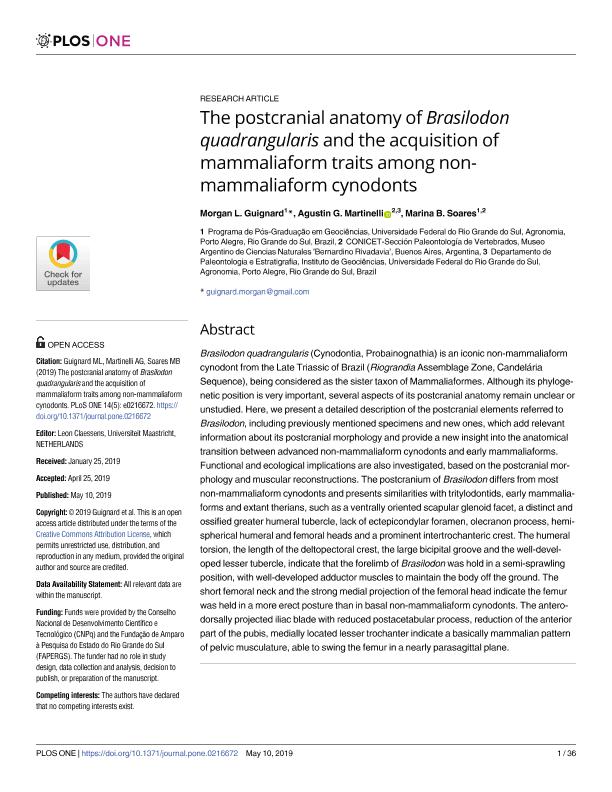Mostrar el registro sencillo del ítem
dc.contributor.author
Guignard, Morgan L.
dc.contributor.author
Martinelli, Agustín Guillermo

dc.contributor.author
Soares, Marina

dc.date.available
2021-01-27T22:44:24Z
dc.date.issued
2019-05
dc.identifier.citation
Guignard, Morgan L.; Martinelli, Agustín Guillermo; Soares, Marina; The postcranial anatomy of Brasilodon quadrangularis and the acquisition of mammaliaform traits among non-mammaliaform cynodonts; Public Library of Science; Plos One; 14; 5; 5-2019; 1-36
dc.identifier.issn
1932-6203
dc.identifier.uri
http://hdl.handle.net/11336/123960
dc.description.abstract
Brasilodon quadrangularis (Cynodontia, Probainognathia) is an iconic non-mammaliaform cynodont from the Late Triassic of Brazil (Riograndia Assemblage Zone, Candelária Sequence), being considered as the sister taxon of Mammaliaformes. Although its phylogenetic position is very important, several aspects of its postcranial anatomy remain unclear or unstudied. Here, we present a detailed description of the postcranial elements referred to Brasilodon, including previously mentioned specimens and new ones, which add relevant information about its postcranial morphology and provide a new insight into the anatomical transition between advanced non-mammaliaform cynodonts and early mammaliaforms. Functional and ecological implications are also investigated, based on the postcranial morphology and muscular reconstructions. The postcranium of Brasilodon differs from most non-mammaliaform cynodonts and presents similarities with tritylodontids, early mammaliaforms and extant therians, such as a ventrally oriented scapular glenoid facet, a distinct and ossified greater humeral tubercle, lack of ectepicondylar foramen, olecranon process, hemispherical humeral and femoral heads and a prominent intertrochanteric crest. The humeral torsion, the length of the deltopectoral crest, the large bicipital groove and the well-developed lesser tubercle, indicate that the forelimb of Brasilodon was hold in a semi-sprawling position, with well-developed adductor muscles to maintain the body off the ground. The short femoral neck and the strong medial projection of the femoral head indicate the femur was held in a more erect posture than in basal non-mammaliaform cynodonts. The anterodorsally projected iliac blade with reduced postacetabular process, reduction of the anterior part of the pubis, medially located lesser trochanter indicate a basically mammalian pattern of pelvic musculature, able to swing the femur in a nearly parasagittal plane.
dc.format
application/pdf
dc.language.iso
eng
dc.publisher
Public Library of Science

dc.rights
info:eu-repo/semantics/openAccess
dc.rights.uri
https://creativecommons.org/licenses/by/2.5/ar/
dc.subject
PROBAINOGNATHIA
dc.subject
CYNODONTIA
dc.subject
TRIASSIC
dc.subject
ANATOMY
dc.subject.classification
Paleontología

dc.subject.classification
Ciencias de la Tierra y relacionadas con el Medio Ambiente

dc.subject.classification
CIENCIAS NATURALES Y EXACTAS

dc.title
The postcranial anatomy of Brasilodon quadrangularis and the acquisition of mammaliaform traits among non-mammaliaform cynodonts
dc.type
info:eu-repo/semantics/article
dc.type
info:ar-repo/semantics/artículo
dc.type
info:eu-repo/semantics/publishedVersion
dc.date.updated
2020-11-26T17:52:47Z
dc.journal.volume
14
dc.journal.number
5
dc.journal.pagination
1-36
dc.journal.pais
Estados Unidos

dc.journal.ciudad
San Francisco
dc.description.fil
Fil: Guignard, Morgan L.. Universidade Federal do Rio Grande do Sul; Brasil
dc.description.fil
Fil: Martinelli, Agustín Guillermo. Universidade Federal do Rio Grande do Sul; Brasil. Consejo Nacional de Investigaciones Científicas y Técnicas. Oficina de Coordinación Administrativa Parque Centenario. Museo Argentino de Ciencias Naturales "Bernardino Rivadavia"; Argentina
dc.description.fil
Fil: Soares, Marina. Consejo Nacional de Investigaciones Científicas y Técnicas. Oficina de Coordinación Administrativa Parque Centenario. Museo Argentino de Ciencias Naturales "Bernardino Rivadavia"; Argentina. Universidade Federal do Rio Grande do Sul; Brasil
dc.journal.title
Plos One

dc.relation.alternativeid
info:eu-repo/semantics/altIdentifier/doi/http://dx.doi.org/10.1371/journal.pone.0216672
dc.relation.alternativeid
info:eu-repo/semantics/altIdentifier/url/https://journals.plos.org/plosone/article?id=10.1371/journal.pone.0216672
dc.relation.alternativeid
info:eu-repo/semantics/altIdentifier/url/https://www.ncbi.nlm.nih.gov/pmc/articles/PMC6510408/
Archivos asociados
